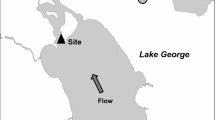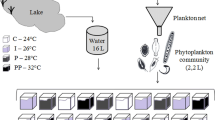Abstract
Freshwater lakes are biologically sensitive to changes in the surrounding environment and the impacts that such changes have on their water quality are of considerable ecological, recreational and economic importance. In this study the phytoplankton community model, PROTECH, was used to experiment with the effects of elevated temperatures and increased nutrient load on phytoplankton succession and productivity. The response of a phytoplankton community to combined incremental changes in these drivers was analysed, in order to elucidate the resulting ecological changes. Annual mean phytoplankton biomass increased with increases in temperature and nutrient loading, although the latter had the larger effect. The phenology of the dominant phytoplankton taxa changed with increasing water temperature; the three spring blooming species all peaked earlier in the year. The simulated summer bloom of Anabaena became earlier in the year and the Chlorella bloom later. The increased phytoplankton biomass was largely dominated by the cyanobacterium Anabaena, which was especially prevalent during the summer bloom. This resulted in a progressive loss of phytoplankton biodiversity with increasing water temperature and nutrient supply. Model experimentation showed that whilst both factors greatly affected the community, the changes to nutrient loading generally had the greater effect and that at low nutrient levels the effect of water temperature change was reduced considerably. Finally, the model predicted that cyanobacteria have the potential to dominate the phytoplankton community, with clear consequences for water quality, and that this dominance was at its greatest when high water temperatures were combined with high nutrient loads.
Similar content being viewed by others
References
L. Carvalho A. Kirika (2003) ArticleTitleChanges in shallow lake functioning: response to climate change and nutrient reduction Hydrobiologia 506 789–796 Occurrence Handle10.1023/B:HYDR.0000008600.84544.0a
M. Edwards A. J. Richardson (2004) ArticleTitleImpact of climate change on marine pelagic phenology and trophic mismatch Nature 430 881–884 Occurrence Handle10.1038/nature02808 Occurrence Handle1:CAS:528:DC%2BD2cXmslCnu7k%3D Occurrence Handle15318219
J. A. Elliott S. J. Thackeray (2004) ArticleTitleThe simulation of phytoplankton in shallow and deep lakes using PROTECH Ecological Modelling 178 357–369 Occurrence Handle10.1016/j.ecolmodel.2004.02.012 Occurrence Handle1:CAS:528:DC%2BD2cXlvV2rtr4%3D
J. A. Elliott S. J. Thackeray C. Huntingford R. Jones (2005) ArticleTitleCombining a Regional Climate Model with a phytoplankton community model to predict future changes in phytoplankton in lakes Freshwater Biology 50 1404–1411
D. Gerten R. Adrian (2000) ArticleTitleClimate-driven changes in spring plankton dynamics and the sensitivity of shallow polymictic lakes to the North Atlantic Oscillation Limnology & Oceanography 45 1058–1066
D. Harper (1992) Eutrophication of freshwaters: principles, problems and restoration Chapman & Hall London
W. Lampert U. Sommer (1997) Limnoecology: The Ecology of Lakes and Streams Oxford University Press New York
D. M. Lewis J. A. Elliott M. F. Lambert C. S. Reynolds (2002) ArticleTitleThe simulation of an Australian reservoir using a phytoplankton community model (PROTECH) Ecological Modelling 150 107–116 Occurrence Handle10.1016/S0304-3800(01)00466-5 Occurrence Handle1:CAS:528:DC%2BD38Xjt1Sqt7Y%3D
Ramsbottom, A. E., 1976. Depth charts of the Cumbrian lakes. Freshwater Biological Association.
C. S. Reynolds (1984) The Ecology of Freshwater Phytoplankton Cambridge University Press Cambridge
C. S. Reynolds (1997b) Vegetation Processes in the Pelagic: A Model for Ecosystem Theory Ecology Institute Germany
C. S. Reynolds A. E. Irish J. A. Elliott (2001) ArticleTitleThe ecological basis for simulating phytoplankton responses to environmental change (PROTECH) Ecological Modelling 140 271–291 Occurrence Handle10.1016/S0304-3800(01)00330-1 Occurrence Handle1:CAS:528:DC%2BD3MXkt1Kgtro%3D
C. E. Shannon W. Weaver (1949) The Mathematical Theory of Communication University of Illinois Urbana
Thackeray, S. J., S. C. Maberly & I. J Winfield, 2005. The Ecology of Bassenthwaite Lake. Freshwater Forum, 25 (in press).
M. Winder D. E. Schindler (2004) ArticleTitleClimatic effects on the phenology of lake processes Global Change Biology 10 1844–1856 Occurrence Handle10.1111/j.1365-2486.2004.00849.x
Author information
Authors and Affiliations
Corresponding author
Rights and permissions
About this article
Cite this article
Elliott, J.A., Jones, I.D. & Thackeray, S.J. Testing the Sensitivity of Phytoplankton Communities to Changes in Water Temperature and Nutrient Load, in a Temperate Lake. Hydrobiologia 559, 401–411 (2006). https://doi.org/10.1007/s10750-005-1233-y
Received:
Revised:
Accepted:
Issue Date:
DOI: https://doi.org/10.1007/s10750-005-1233-y




